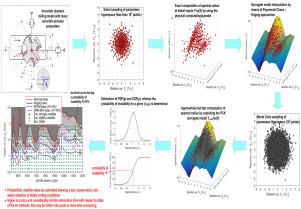International Journal of Machine Tools and Manufacture ( IF 14.0 ) Pub Date : 2020-07-30 , DOI: 10.1016/j.ijmachtools.2020.103610 G. Totis , M. Sortino

|
After more that 60 years of investigation, chatter vibrations in metal cutting are still a major cause for poor surface finish and machine tool damage. In order to avoid undesired machining conditions, chatter prediction algorithms may be applied to draw stability charts that allow a preliminary identification of the safe areas. Nevertheless, the stability boundaries are sensitive to the variations and uncertainties of the dynamic milling model coefficients. Thus, the accuracy and reliability of the obtained predictions can be inadequate for many industrial applications. For solving this problem, robust methods were recently devised that are fast but usually too conservative. On the other side, probabilistic approaches were also developed to estimate the probability of instability for a given combination of cutting parameters, by taking into account the statistical distributions of model coefficients. Probabilistic approaches allow a less conservative, risk-aware selection of stable cutting conditions. Unfortunately, their application is still very limited due to the required large amount of computational power and time. In this work, three novel probabilistic methods based on Polynomial Chaos and Kriging metamodels (PCE, KRI and PCK) were compared to state of the art probabilistic algorithms (MC, MC-SPA, DRM-SPA, RCPM). The numerical analysis and the experimental validation proved that MC-SPA, DRM-SPA, RCPM and PCE are too rough and thus needless for industrial applications. On the contrary, KRI and in some cases also PCK showed an excellent accuracy together with significantly shorter elaboration time than that required by the reference Monte Carlo (MC) technique.
中文翻译:

多项式混沌克里格方法在铣削中有效的概率颤动预测
经过60多年的研究,金属切削中的颤振仍然是造成表面质量差和机床损坏的主要原因。为了避免不希望的加工条件,颤振预测算法可以用于绘制稳定性图表,从而可以初步识别安全区域。然而,稳定性边界对动态铣削模型系数的变化和不确定性敏感。因此,对于许多工业应用来说,所获得的预测的准确性和可靠性可能不足。为了解决这个问题,最近设计了快速但通常过于保守的鲁棒方法。另一方面,还开发了概率方法来估计切削参数给定组合的不稳定性概率,通过考虑模型系数的统计分布。概率方法允许选择不太保守的风险意识的稳定切削条件。不幸的是,由于所需的大量计算能力和时间,它们的应用仍然非常有限。在这项工作中,将基于多项式混沌和Kriging元模型(PCE,KRI和PCK)的三种新颖的概率方法与最新的概率算法(MC,MC-SPA,DRM-SPA,RCPM)进行了比较。数值分析和实验验证证明,MC-SPA,DRM-SPA,RCPM和PCE过于粗糙,因此对于工业应用而言是不必要的。相反,与参考蒙特卡洛(MC)技术所需的时间相比,KRI以及在某些情况下PCK也显示出优异的精度,并且加工时间大大缩短。



























 京公网安备 11010802027423号
京公网安备 11010802027423号